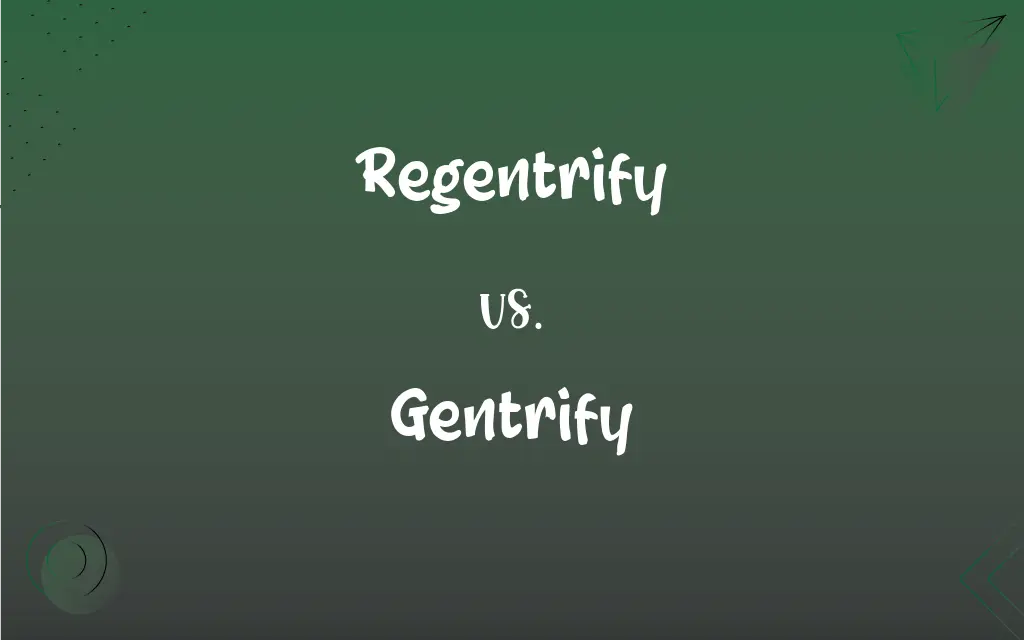Regentrify vs. Gentrify: What's the Difference?
By Harlon Moss & Janet White || Updated on May 23, 2024
Gentrify refers to the process of urban renewal where wealthier people move into a lower-income neighborhood, often displacing current residents. Regentrify emphasizes the idea of restoring an area to its former, often wealthier state.

Key Differences
Gentrify refers to the socio-economic transformation of a neighborhood when affluent individuals move in, leading to increased property values and the displacement of lower-income residents. Regentrify, on the other hand, specifically highlights the restoration of a neighborhood to its previous affluent status. It suggests a return to a former state of wealth and prestige rather than a new wave of affluence.
Gentrify typically involves new investments in housing, businesses, and infrastructure, attracting higher-income residents and altering the neighborhood's character. This influx can lead to higher rents and property taxes, making it unaffordable for long-time residents. Regentrify involves similar investments but with a focus on historical restoration. This process often involves renovating old buildings and reviving historical landmarks, aiming to bring back the neighborhood’s former glory rather than just making it modern and expensive.
Gentrify is often criticized for its social impact, including the displacement of lower-income residents and loss of cultural heritage. Critics argue it benefits newcomers at the expense of original inhabitants, creating economic and social divides. Regentrify can also face criticism but is sometimes seen more positively if it includes efforts to preserve historical and cultural aspects of the neighborhood. It can be viewed as a means of cultural preservation rather than purely economic exploitation.
Gentrify typically results in demographic shifts, with a more homogeneous, wealthier population replacing a more diverse, lower-income community. This shift can change the social fabric and identity of the neighborhood. Regentrify may result in similar demographic changes but with an added layer of historical and cultural reclamation. The focus on restoring historical elements can sometimes make the transition smoother, though challenges related to displacement and affordability remain.
Comparison Chart
Definition
Urban renewal by wealthier individuals moving in
Restoration of an area to its former affluent state
ADVERTISEMENT
Focus
Economic growth and modernization
Historical restoration and cultural revival
Impact on Residents
Displacement of lower-income residents
Possible displacement but with historical focus
Criticism
Social inequality, cultural erasure
Displacement concerns, but sometimes viewed as preservation
Demographic Change
Homogeneous, wealthier population
Similar demographic shifts with historical context
Regentrify and Gentrify Definitions
Regentrify
Urban renewal.
The city plans to gentrify the old district, attracting new businesses.
ADVERTISEMENT
Gentrify
Historical focus.
Projects to regentrify often involve preserving old architecture.
Regentrify
Increase in property values.
As neighborhoods gentrify, property values tend to rise significantly.
Gentrify
Cultural revival.
Plans to regentrify the neighborhood include restoring cultural landmarks.
Regentrify
Displacement of residents.
Long-term residents are often displaced when areas gentrify.
Gentrify
Returning wealth.
The initiative to regentrify seeks to bring back the area's former wealth.
Regentrify
Economic growth.
Gentrify the area to stimulate local economic development.
Gentrify
Restoration to former status.
The city aims to regentrify the historic downtown area.
Regentrify
Modernization.
Efforts to gentrify the neighborhood have brought in modern amenities.
Gentrify
Economic and historical restoration.
Efforts to regentrify the area are seen as both economic and historical investments.
Regentrify
To gentrify again.
Gentrify
To subject to gentrification
Gentrify a row of Victorian houses.
Gentrify
To undergo gentrification
A neighborhood that is rapidly gentrifying.
Gentrify
(transitive) To renovate or improve something, especially housing or district, to make it more appealing to the middle classes (often with the negative association of pricing out existing residents).
Gentrify
Renovate so as to make it conform to middle-class aspirations;
Gentrify a row of old houses
Gentrify the old center of town
FAQs
Is regentrify a commonly used term?
Regentrify is less common than gentrify but is used to emphasize historical restoration.
Can gentrification be positive?
Yes, it can bring economic growth and improved amenities, though it often has negative social impacts.
What does regentrify imply about the history of a neighborhood?
It implies that the neighborhood was once affluent and the goal is to restore it to that status.
What is the main difference between gentrify and regentrify?
Gentrify refers to urban renewal by wealthier individuals moving in, while regentrify focuses on restoring an area to its previous affluent state.
Does gentrify always involve displacement?
Often, yes. Gentrification can lead to the displacement of lower-income residents due to rising costs.
Are gentrify and regentrify interchangeable?
No, they have different connotations and focuses. Gentrify is about new development, while regentrify is about restoration.
Does regentrify focus on modern amenities?
Not primarily; it focuses more on historical and cultural restoration while incorporating modern amenities.
What is a common criticism of gentrify?
A common criticism is that it displaces long-term, lower-income residents.
Does regentrify face similar criticisms as gentrify?
Yes, it can face criticism for displacement, but it is sometimes viewed more positively for preserving history.
Can gentrify improve local infrastructure?
Yes, gentrification often leads to improved infrastructure and amenities.
How does gentrify affect cultural heritage?
Gentrification can lead to the erasure of cultural heritage as new, wealthier residents move in.
What is a benefit of regentrify?
A benefit is the restoration and preservation of historical landmarks and cultural sites.
What is an economic impact of gentrify?
It can stimulate local economic growth and attract new businesses.
What sectors are involved in gentrify?
Real estate, retail, and local government are typically involved in gentrification efforts.
How does regentrify impact local businesses?
It can revitalize local businesses, especially those with historical significance.
Does gentrify always increase property values?
Generally, yes. Gentrification usually leads to increased property values.
How does gentrify change neighborhood demographics?
It often results in a wealthier, less diverse population.
Can regentrify attract tourism?
Yes, by restoring historical sites, regentrification can attract tourists interested in the area’s heritage.
Does regentrify always restore historical accuracy?
Not always, but it often aims to maintain or revive historical and cultural elements.
Is regentrify more community-friendly?
It can be, especially if it involves preserving cultural and historical elements valued by the community.
About Author
Written by
Harlon MossHarlon is a seasoned quality moderator and accomplished content writer for Difference Wiki. An alumnus of the prestigious University of California, he earned his degree in Computer Science. Leveraging his academic background, Harlon brings a meticulous and informed perspective to his work, ensuring content accuracy and excellence.
Co-written by
Janet WhiteJanet White has been an esteemed writer and blogger for Difference Wiki. Holding a Master's degree in Science and Medical Journalism from the prestigious Boston University, she has consistently demonstrated her expertise and passion for her field. When she's not immersed in her work, Janet relishes her time exercising, delving into a good book, and cherishing moments with friends and family.
































































